Climate change: glass half-full or half-empty?
Paris, December 1, 2015 -- As a reporter covering climate change, one of the big questions – arguably THE big question – I grapple with is this: are we on the right track to prevent catastrophic global warming? Confronted recently with diametrically opposed answers, I took a deep dive to find out which one was right.
A little background: Unless humanity radically and rapidly decarbonizes the global economy – i.e. stops using fossil fuels – the rock we call home will soon become far less hospitable for our species than it has been over the last 11,000 years. Right now, we’re aboard an express train hurtling toward a world four degrees Celsius hotter than when global warming began in the mid-19th century. Trust me, you really, really, really don’t want to go there.
To stay on the safe side, says the UN’s 3,000-strong panel of climate scientists, we need to cap the rise in temperature at two degrees. That’s the holy-grail objective of the 195 nations gathering in Paris this week to thrash out a climate pact. Nearly 180 of them have made cross-my-heart pledges to curb their greenhouse gas emissions, which means that every player which matters has skin in the game. That’s already an accomplishment – the 20-year process has been akin to herding cats.
Please take a moment to wish them luck.
So, how close will the Paris pledges bring us to the 2 C goal? The United Nations issued two major analyses recently to provide an answer.
Both reports – one from the UN Framework Convention on Climate Change (UNFCCC), the ringmaster of the UN climate circus, and the other from the UN Environment Programme – conclude that the climate rescue plans from China, the US, the EU, India, Russia and all their siblings in the raucous family of nations put us on a pathway to a more-or-less 3 C world – half-way between where we we’re headed now (4 C) and where we want to go (2 C). The pledges take effect in 2020 and, in most cases, run until 2030.
An even more precise measure than temperature for progress toward the 2 C target is something called the ‘carbon budget’. It is an unnervingly simple concept: science has calculated that our species has a lump-sum, fixed allowance for emitting greenhouse gases into the atmosphere. Exceed it, and our chances of staying under the two degree threshold go up in smoke.
 Fog outside of Lahore, Pakistan. December, 2014. (AFP / Arif Ali)
Fog outside of Lahore, Pakistan. December, 2014. (AFP / Arif Ali)Starting from today, that allowance is roughly one trillion tonnes of carbon dioxide. Last year, human activity emitted about 40 billion tonnes. Do that math: at that rate, we will exhaust our budget in less than 30 years. In reality, we will draw down our credit even faster because emissions – even taking the national pledges into account – are set to keep growing year-by-year until at least 2030. (Nerdy footnote #1: there are other important greenhouse gases such as methane [think cows] and nitrous oxide [think cars]. When these are included in carbon budget calculations, the unit of measure becomes “carbon dioxide (and its) equivalent”, or CO2e. But accurate timelines can be drawn looking just at CO2, which accounts for more than 80% of the problem.)
Reading the reports, of course, we want to know: is the news good or bad? Give it to us straight, Doc, what are our chances of pulling through? The answer, I found out, depends on who you talk to.
As I reported on the carbon-cutting pledges – known in climate jargon as ‘intended nationally determined contributions’, or INDCs for short – I came across a study in the peer-reviewed journal Global Policy making a wildly different claim: on their own, it said, the INDCs would only shave off about 0.05 C off the expected rise in temperature by the end of the century. The Paris pledges, in other words, would barely make a dent.
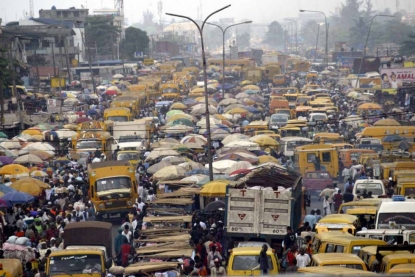 Congestion in Lagos, February, 2006. (AFP / Pius Utomi Ekpei)
Congestion in Lagos, February, 2006. (AFP / Pius Utomi Ekpei)The author was Danish researcher Bjorn Lomborg, an ‘enfant terrible’ in environmental policy circles because of his heretical view – first outlined in his 2001 book “The Skeptical Environmentalist “ – that humanity is wasting time and money in a largely futile effort to reduce carbon emissions. Better to invest, he says, in R&D for future green technologies and to brace for climate change impacts already in the pipeline. Compared to eradicating hunger, AIDS or TB, he argues, global warming is a low priority.
These ideas are, I think, dangerously wrong. But I still had to contend with Lomborg’s reading of the INDCs. Quite simply, he says that the national pledges, on their own, will barely bend the curve of greenhouse gas emissions over the long haul, completely exploding the carbon budget in the process.
Faced with these opposing interpretations, I went in search of a neutral referee to find out who was telling the truth. That would be Jean-Pascal Ypersele, a much-respected Belgian scientist and, until this year, Vice Chair of the UN Intergovernmental Panel on Climate Change. To be honest, I expected Ypersele to dismantle Lomborg’s argument with a deft stroke or two – something I had been unable to do in a long conversation with the media-savvy Dane.
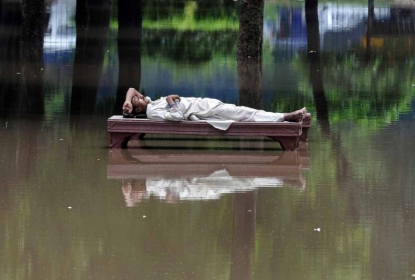 A man rests on a bench amid floodwater in Lahore, Pakistan. July, 2008. (AFP / Arif Ali)
A man rests on a bench amid floodwater in Lahore, Pakistan. July, 2008. (AFP / Arif Ali)Speaking by phone, Ypersele was upset. Lomborg, he said, was “excessively pessimistic” and only looked at worst-case scenarios. “He assumes that after 2030 there would be no further efforts to reduce emissions.” I agreed that this was not a reasonable assumption – one of the main questions on the table in Paris over the next two weeks is how to put in place a mechanism to ensure that countries will continue to ratchet up their carbon-cutting plans.
But Lomborg was not claiming to anticipate everything that might happen in the future. He was taking a cold, hard look at how far the Paris pledges we have in hand would take us. “What Lomborg is saying, I think, is this: ‘Hey, let’s be honest – right now the glass is 90 percent empty’. Is that fair to say?,” I asked Ypersele.
Long pause. An audible sigh. “Yes. He points to the importance of what happens after 2030. On that, he is right.” Does that mean, I continued, that the UN estimates are wrong? Another long pause. “No. It all depends on the assumptions you make.”
And that, finally, brings us to the heart of the matter. The problem I had uncovered was not a disagreement over the science. There is remarkably little of that. The problem is a disagreement over how we talk about climate change, and how we describe the prospects for a liveable future.
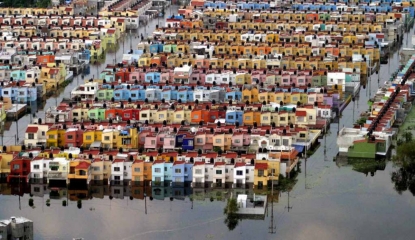 The flooded neighborhood of Villahermosa in Mexico. November, 2007. (AFP / Gilberto Villansana)
The flooded neighborhood of Villahermosa in Mexico. November, 2007. (AFP / Gilberto Villansana)When it comes to communicating about global warming and our efforts to curb it, the UN faces a lose-lose dilemma. Highlight the potential for a positive outcome, and you give people a false sense of security; tell them how easily and badly things could go wrong, and they may throw up their hands in despair and walk away. So the UN does both. The carefully calibrated press releases for the two reports were bipolar, shuttling between self-congratulations and stern warnings, reasons to cheer and reasons to fear.
But the main mission of the UN is to build political and popular support for strong action on climate, so in the end good intentions trump clear-eyed analysis. The glass will always be half full: “2 C still within reach,” “Unprecedented worldwide effort,” etc. Climate policy think tanks and NGOs –major players with, in some cases, staff numbering in the thousands and budgets in the hundreds of millions – face the same half-full/half-empty quandary, and most of them also wind up handing out rose-tinted glasses. It’s their job. Bill McKibben, founder of 350.org, is one activist who has walked that threadbare tightrope between hope and gloom with extraordinary skill, helping to generate a global grassroots movement in the process. At the end of the day, though, his aim is likewise to get and keep people on board.
For most journalists, especially news agency reporters, that is anathema. We don’t do ‘messaging,’ we do news. The same holds for science, where the integrity of the scientific method depends on an absence of bias.
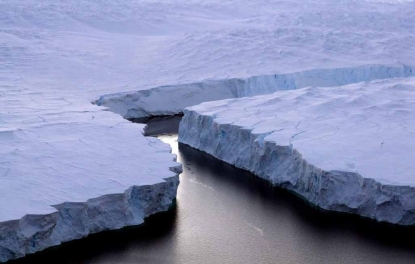 An iceberg breaks off the Knox Coast in the Australian Antarctic Territory. January, 2008. (AFP / Pool / Torsten Blackwood)
An iceberg breaks off the Knox Coast in the Australian Antarctic Territory. January, 2008. (AFP / Pool / Torsten Blackwood)Which is why I have been fascinated to see a shift – both in the newsroom and among scientists – in these unspoken rules when it comes to climate change.
Because AFP received both UN reports under embargo several days before their release, beat reporters like myself had plenty of time to mull them over. (While the job of writing an article will fall to a single journalist, we value input from colleagues.) Normally, our disagreements center on the best angle for a story, or how much prominence it merits. This time, however, we veered into new territory.
“We can’t keep delivering bad news about the climate,” one colleague said when I suggested that one of the reports was more glass ‘half-empty’ than ‘half-full.’ “It’s too depressing.” Another colleague had button-holed me a few weeks earlier to berate me for writing an unrelentingly bleak blog entry about climate change. “Talks about the success stories,” she admonished. A third journalist covering the environment, rings around her eyes, said she had stayed awake most of the previous night searching for a way to inject a positive note into a story about tipping points, latent natural phenomena that could – if triggered – accelerate global warming beyond our control.
 A rusted ship rests on the dried-up bed of the Aral Sea. August, 2005. (AFP / Vyacheslav Oseledko)
A rusted ship rests on the dried-up bed of the Aral Sea. August, 2005. (AFP / Vyacheslav Oseledko)Starting a few months ago, I began to ask climate scientists why they had chosen their field, and if they were alarmed by their own findings. Normally, the kind of scientist who wears a white lab coat and thinks in equations will shy away from editorializing about his or her work. Way outside their comfort zone. But the harrowing realities of climate change loom so large, that these boundaries have begun to break down. Several prominent climate scientists, for example, in the United States – Michael Mann, James Hansen – have become activists.
“It is perhaps because of my scientific understanding that I am very concerned,” Peter Clark, a professor at the College of Earth, Ocean and Atmospheric Sciences at Oregon State University wrote at the end of a long email larded with the kind of cautions and caveats – in this case about melting glaciers – that make it hard for a reporter to write a dramatic lede. “Unless we make a concerted effort to not only reduce but entirely stop carbon emissions soon, we are on a trajectory that will fundamentally change the world as we have known it since the dawn of civilization.”
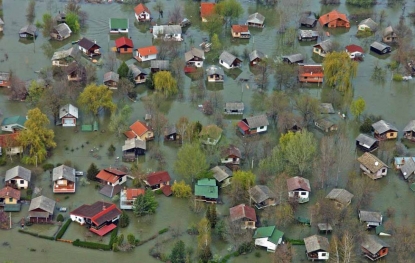 The flooded Serbian town of Beocin. April, 2006. (AFP / stringer)
The flooded Serbian town of Beocin. April, 2006. (AFP / stringer)The UN reports zoom in on the period covered by the INDCs, up to 2030. On that scale, the gap between the different CO2 emissions trajectories – “business as usual,” the Paris pledges, the two degree target – seem less daunting. But if you extend those lines out to the end of the century, suddenly the gap begins to look unbridgeable.
Ysperele is right: Lomborg’s projections are particularly grim because they assume that the world’s nations will make no further efforts to cool the planet beyond their Paris promises, and that is a very, very unlikely scenario. His argument is, in that sense, disingenuous.
But look at the small print of the UN reports, as you’ll find another set of assumptions that may be just as unrealistic.
(AFP Graphics)
•Reaching the two degree target, for example, presumes that the global economy will be carbon neutral sometime around 2070, meaning that humanity cannot excrete more CO2 than Earth can absorb. It also depends, in the UN scenarios, on a raft of technologies that have fallen short of expectations (carbon capture and storage, of CCS), cause problems of their own (biofuels, nuclear), or don’t yet exist, at least not on anything approaching an industrial scale (direct carbon capture – sucking CO2 out of the air).
•Oh yes, did anyone mention that we will almost certainly overshoot the 2 C target? Earth has already heated up by 1 C, and there’s another 0.6 C in the pipeline – what scientists call “committed warming” – even if we were to switch off every mechanical source of CO2 before Christmas. “There is hope that we’ll be able to turn the juggernaut around,” said Peter Cox, a climate modeller and expert on geoengineering at the University of Exeter. “But not fast enough to avoid two degrees.” Oops.
•And never mind that 2 C is probably not good enough anyhow, at least not for a couple billion people living less than a few meters above sea level or in regions already hardening into sun-baked deserts. One recent report concluded that a 2 C rise in temperature will be enough to cover land currently inhabited by 280 million people. (Nerdy footnote #2: The 2 C objective was delivered not by science, but – with forceps – by the nearly-collapsed 2009 climate summit in Copenhagen, where world leaders expecting nothing more strenuous than a group photo and a coupe of Champagne wound up working through the night to produce a face-saving, three-page ‘accord’ with no legal standing.)
•While we’re at it, we might as well point out that the UN’s forecasts assume that all these carbon-cutting promises will be kept, that we can successfully monitor and measure them, and that the money many poor countries demand in return will be delivered.
•And perhaps the UN would explain why – after prominently insisting in five previous reports that greenhouse gas emissions must peak no later than 2020 – the very concept of a ‘peak year’ disappeared from the 2015 edition? Could it be because we now know that carbon pollution will continue to climb for the next 15 years even with the Paris pledges?
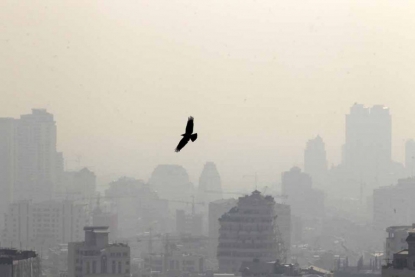 The polluted skyline of Tehran. January, 2013. (AFP / Atta Kenare)
The polluted skyline of Tehran. January, 2013. (AFP / Atta Kenare)The obvious solution to global warming has long been to curb our output of greenhouse gases by weaning the global economy of fossil fuels. But we have not done that, so the pathway to a two degree world has grown narrower over time. Can we still get there from here? Of course we can. The brass ring is within our grasp. A few more turns of the merry-go-round, we’re told, and we just might be able to grab it.
Marlowe Hood is AFP's environment and science reporter based in Paris. Follow him on Twitter.
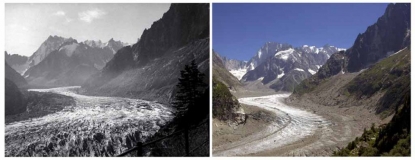 The 'Mer de Glace' glacier on France's Mont Blanc in the 1940s (l) and in July, 2003 (r). (AFP / Jean-Pierre Clatot)
The 'Mer de Glace' glacier on France's Mont Blanc in the 1940s (l) and in July, 2003 (r). (AFP / Jean-Pierre Clatot)

